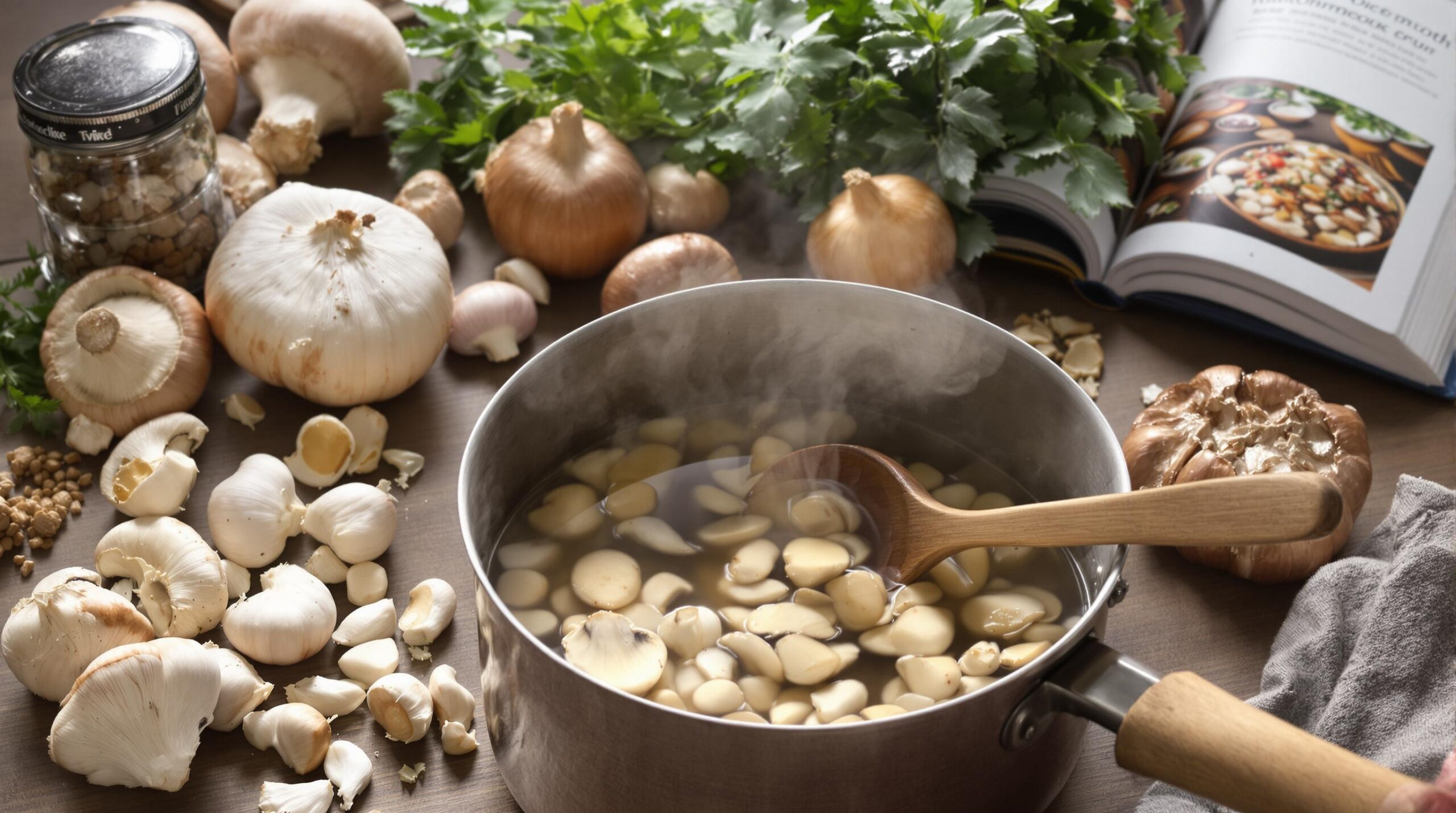Unlocking umami, often called the fifth taste, elevates culinary experiences. This savory sensation doesn’t just enhance flavors; it transforms them. Homemade mushroom broth is a rich umami source that captures this depth. Crafting this broth at home allows control over flavors, ingredients, and health benefits, making it preferable to store-bought versions.
The Allure of Umami
Umami, a Japanese term meaning “pleasant savory taste,” was scientifically recognized in the early 20th century. It’s a taste sensation beyond sweet, sour, salty, or bitter, often meaty and earthy. This flavor primarily arises from glutamate and ribonucleotides in foods. Mushrooms, boasting rich umami properties, are perfect for crafting homemade broth. Their meaty textures and deep flavors meld beautifully, creating a foundation for various dishes.
Choosing the Right Mushrooms
Selecting quality mushrooms significantly affects your broth’s flavor profile. Each mushroom variety offers unique taste notes and benefits. Shiitake mushrooms are known for their robust, smoky flavor. They infuse broths with a deep, almost meaty depth of taste. Cremini and portobello mushrooms bring earthy richness and add body. Dried mushrooms offer concentrated flavor and are excellent additions due to intensified glutamate levels.
For a balanced broth, consider mixing different types of mushrooms. This blends distinct flavors, creating complexity in the final product. Always choose fresh, firm mushrooms when buying, and keep the dried ones on hand for depth.
Preparing the Ingredients
Wash your mushrooms gently to remove dirt without soaking them in water. Excess water can dilute flavors. Slice or quarter the mushrooms to increase their surface area, allowing them to release flavors more efficiently. Include mushroom stems in your preparation. They contain significant flavor and nutrients, contributing significantly to the umami profile of the broth.
Aromatic vegetables, in addition to mushrooms, form the broth’s base. Onions, garlic, and carrots bring sweetness and complexity. Celery adds subtle bitterness, balancing the broth. Consider adding kombu, a type of seaweed, to enhance umami through the natural glutamates it contains.
Crafting the Broth
Begin by sautéing the mushrooms and aromatics. Use a neutral oil, such as grapeseed or olive oil, and cook until they are browned. This browning process, known as the Maillard reaction, intensifies flavor. It’s essential for unlocking the full umami potential. Once browned, add water, ensuring it fully covers the ingredients. Using cold water helps draw flavors out more effectively during the simmering process.
Bring the mixture to a gentle simmer, avoiding high heat, which can cloud the broth. Simmer for at least an hour, letting the flavors meld and deepen. As the broth cooks, impurities may rise to the surface as foam. Skim these regularly to maintain clear broth.
Elevating the Flavor
Consider spices and herbs to further enhance flavors. Bay leaves introduce subtle, nuanced flavors. Thyme and rosemary add aromatic depth, beautifully complementing the mushrooms’ earthiness. Add these during the simmering process, allowing their flavors to infuse gradually.
Taste the broth midway through cooking and adjust salt levels accordingly. Salt accentuates the natural umami, but balance is key. Remember, over-salting at this stage could overpower other flavors.
Straining and Storing the Broth
Once the broth has developed its deep umami flavor, it’s time to strain. Use a fine mesh strainer or cheesecloth to remove solids. This step ensures a smooth, clean broth. The resulting liquid should be clear with a rich golden-brown hue.
Transfer the strained broth into airtight containers. Store it in the refrigerator for up to a week or freeze for six months. Freezing broth in ice cube trays is an efficient way to have small, ready-to-use portions on hand. This storage technique preserves the broth’s flavor and nutrient content.
Incorporating Mushroom Broth in Your Dishes
Homemade mushroom broth serves as an excellent base for a variety of dishes. It enriches soups, adding layers of flavor and warmth. Use it in risotto, and observe how it transforms the usual creamy texture into something extraordinary.
Try substituting mushroom broth for water when cooking grains or beans. This simple swap adds a depth of flavor that water couldn’t achieve. The versatile use of this broth extends to sauces and gravies, enhancing savory profiles and adding complexity.
A Nutrient-Rich Option
Beyond its rich umami taste, mushroom broth offers numerous health benefits. Mushrooms are low in calories yet high in fiber, vitamins, and minerals. They are also a good source of antioxidants, which fight free radicals, reducing oxidative stress in the body.
Mushroom broth is also naturally gluten-free and suitable for vegan and vegetarian diets. It can be essential in plant-based nutrition plans, boosting flavor without animal products.
Experimenting with Custom Blends
Feel free to experiment with different mushroom combinations and added ingredients. Each change can create a unique broth experience. Add a touch of ginger or lemongrass for an Asian-inspired variation. A soy or fish sauce splash can intensify the umami, offering a more profound, saltier profile.
For a spicier touch, incorporate chili flakes or peppercorns. These variations demonstrate the broth’s versatility, allowing personalization to suit various tastes.
Conclusion
Mastering homemade mushroom broth unlocks the depth of umami and enhances your culinary repertoire. This art enriches dishes and boosts nutritional content and dietary variety. With practice, precision, and creativity, your mushroom broth can become a staple in your kitchen. From soups to sauces, it elevates everyday meals to gourmet experiences. Each pot brewed opens a world of flavors, waiting to be savored and celebrated.

